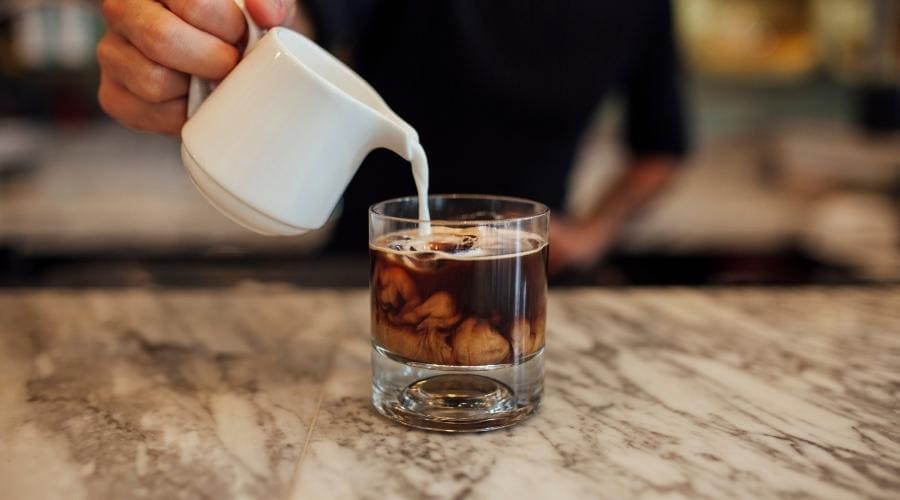
If you seeking a rich and mellow flavored cold brew without the added acidity, there are some parameters you need to consider. One of which is brewing time. I mean, if you accidentally brew too long or not long enough, you will end up with either bitter coffee, sour cardboard, or both.
And none of us would want that. Which begs the question…
Can you really steep cold brew for 48 hours?
Yes, you can. Especially if your cold brew tends to come out on the weaker side. But, in most cases, a 48-hour cold brew will have had way more than the needed time to fully extract. It will look darker, fully dissolved, and most likely taste much bitter.
This is why It’s necessary to take into consideration all other factors when maximizing steep time.
48 Hour Cold Brew – Most Important Tips
The key to getting a 48-hour cold brew flavor right is to compensate for the over-extraction by tuning down other parameters (Temperature, water hardness, grind size…), this will balance out the extraction process
In simpler terms: brew at a lower temperature (definitely not at room temperature in this case), and use sizable coarse ground beans. And I wouldn’t recommend any additional stirring or agitation. Coffee quality should be nailed too, as you can never go wrong with good quality beans when it comes to cold brew.
If you’re interested, check out my article where I’ve listed the best coarse ground coffee for a cold brew this year in terms of freshness, strength, taste, packaging…
And if you still get a super strong, extra-bitter final beverage, you can always dilute it using ice, milk, or any other coffee additive of your choice.
So is 48 hours the Best Steeping Time or Going Too Far?
Neither, really. if you soak coffee for 12 hours, the resulting drink might turn out weak, 18 hours is always a good recommendation for a smooth and rich cold brew.
However, nothing is written in stone. Many coffee lovers would steep the grounds for 24-48 hours, and It’s not unpopular to experiment with steeping time, nor is it wrong. Coffee taste is highly subjective, and a 48-hour cold brew might just be your next favorite drink.
That being said, below are the details of what you need to consider when making a 48-hour cold brew so you don’t lose the richness and flavor of the brew:
Make Use of the Right Grind
OH BOY! This is where you need to put the most effort. Yes, grinding coffee beans too fine will leave your cold brew bitter, for coffee to dissolve in cold water, especially when making a 48-hour cold brew, aim for coarsely ground coffee beans.
Also, the consistency of the grind is important to ensure that your brew extracts evenly.
Use Good Quality Coffee
Another important tip that’s frequently overlooked is: always use high-quality coffee. I mean, you don’t want to come home or kick-start your day with a lousy coffee. And when it comes to a long steeped 48-hour cold brew, coffee bean quality can literally make or break your final result.
Since some of the fruity, vivid coffee grounds tend to lose their punch when brewed slowly, it is always better to go for creamier and balanced coffees.
Experiment with the Ratio of Coffee to Water
When looking up several cold brew techniques, you will see a lot of different recommended ratios of coffee to water. Now, I’ll tell you this: It literally solely depends on you, whether you would like your cold brew to be more on the concentrated side or otherwise.
Keep playing around and find out what works the best for you. As there is no one-size-fits-all solution. YOU DO YOU!
Play around with the Steep Time
Although my proposed recipe has a steep time of 48 hours. If you prefer long steeped cold brew, try experimenting with a 24 hour time frame and keep going up till you hit that 48 hour mark.
Anything between 24 and 48 hours yields great results. Keep experimenting with the time window and see what tastes best for you.
Use Filtered water
Now, I cannot stress this enough; water is not just another ingredient when it comes to coffee brewing. It is the main solvent that extracts all those juicy natural flavors and aromas from the coffee beans straight into your final cup.
When you think of it this way, it becomes apparent how important of a role filtered water plays in the whole process.
Meanwhile, regular tap water is treated with chlorine so it will usually taste and smell a tad bit different.
Not only that, but tap water will also most likely contain tiny particles of rust, dust, and sediment. (source)
All of these factors gravely affect the final taste of coffee. This is why using filtered water is the safest bet when it comes to producing the cleanest and most flavorful cup of cold brew.
24 vs 48 Hour Cold Brew?
While you might not be able to distinguish any tangible difference between a 24h cold brew and a 48-hour steeped cold brew, if you like to have your cold brew with a tinge of bitterness and prefer a strong brew, look no further and opt for a 48-hour window cold brew.
Nonetheless, a 24-hour cold brew is your go-to thing if you want subtle and flavored cold brew coffee.
Below is the comparison of cold brew made under the same circumstances, using the same bean for 24 hours and for 48 hours.
| 24 Hour Cold Brew | 48-Hour Cold Brew |
| Mellow Flavor. | Mellow Flavor, you might not notice a difference in flavor. |
| Less Bitter | Definitely on the bitter side. |
| Concentrated | A little more Concentrated, might need dilution. |
| Strong. | Full Strength, maybe over-extracted. |
How to Make a 48 hour Cold Brew Drink?
Although it has a long steep time, the whole process of making cold brew coffee, in general, is quite simple.
For a 48-hour cold brew, you need to have the following things to get started:
- A filter (rice strainer, cheesecloth, or a paper filter) to Filter out sediment.
- Decanter or carafe for dripping the coffee solution when it is ready.
- Container that could be a pitcher, Mason jar, etc., depending on how much concentrate you want to make.
Also, you can opt for a brewer if you don’t want a mess, but that comes with an extra cost. A brewer system comes with a kit that has everything, you will need to make your brew.
In this article, I’ve listed the best cold brew makers this year, which are made in the original hub of cold brew: Japan.
However, you can make a perfect cold brew using home tools as well, just follow the instructions, and you are good to go!
48 Hour Cold Brew Step by Step
In this section, we will discuss what goes into the quest of making the delicious 48-hour cold brew, from the comfort of your home, without compromising its taste and freshness.
Step 1:
First, you need to grind the coffee beans to a coarse size to avoid over-extraction since a 48-hour cold brew has a long steeping time.
Step 2:
Combine coffee beans with water. The ratio of the two is totally subjective; keep experimenting and find what works out for you and go for that. You can mix the two either directly or using the mesh system to make the final straining of water from coffee beans easier.
Step 3:
Cover the container with the lid and let it steep for 48 hours. There is no hard and fast rule; I’d also suggest you keep playing around with time and see what best suits your schedule, 48 hours is not written in stone, nor is 18 or 24 hours.
Step 4:
Now, you need to strain the mixture, and your cold brew is ready to serve. If you have made cold brew using a cold brew maker with a filter, you just have to remove the filter, and it’s ready to be gulped.
But, if you have mixed the two, you will have to use filter paper or cheesecloth to separate the coffee grounds.
Voila! Your delicious cold brew is ready! you can either drink this straight away if you want more caffeine or can always cut it using milk or creamer —Frothed or steamed.
Does Cold Brew Have More Caffeine than Other Hot or Iced Coffees?
Albeit the cold brew is made at a stronger coffee-to-water ratio, it doesn’t necessarily have to be the case. That’s because it depends on how you would like to have your cup of coffee.
If you are drinking it on a more concentrated level, it has more caffeine. However, if you are diluting your coffee, it doesn’t.
Plus, other factors also contribute to the extra amount of caffeine, including the steep time and the particular brand of the coffee.
Speaking of caffeine, some people even prepare their cold brew coffee decaffeinated, so there’s that.
Can I Leave Cold Brew in the Refrigerator?
Unlike hot coffee, which goes bad within a few hours, you can keep the cold brew coffee in the refrigerator for a long time. An undiluted concentrate will keep in the fridge for up to 2 weeks, although the quality and taste will change after a week. Thus, it is best to use it within a window of 7-9 days.
Can I Make Cold Brew Coffee Using Regular Coffee?
The short answer is yes, you can make cold brew using your favorite regular coffee. However, coarse-ground beans are recommended. That’s because you might end up with thick granular sludge at the bottom of your container if you are using fine coffee beans.
On top of that, the extraction is much more compatible when using coarse ground coffee considering the water temperature is lower than hot brewed coffee.
Cold Brew Coffee vs Hot
What comes to your mind when you think of cold brew? Is it the same regular hot brewed coffee served over ice or cooled? No!
Cold-brew doesn’t heat up; rather than brewing in a matter of a few minutes, it is steeped for 12-48 hours. This translates to a cup of coffee that is more flavorful, rich, and smooth. Studies also show that cold brew coffee is less acidic, and therefore friendlier to your tummy, which is truly the best thing one can ever ask for.
The Takeaway
Nothing beats the joy of having a smooth and refreshing cold brew in the morning. It’s the caffeine-cooling refresher we all need to power up our summer fun (Or any-season-fun that is, but that could just be me).
Cold-brew extracts all of the deliciousness of the coffee beans without all the bitterness and acidity that drip-brew might bring about. It accomplishes this via cold extraction.
That being said, several other factors go into making the best cold brew.
For example, the kind of coffee beans you use is a critical element;
And I would dare say, It doesn’t really matter whether you are opting for a 24-hour or 48-hour window; I would suggest trying out different brewing variations.
That’s because it will help you choose the ideal balance that is just right for your taste buds.
I hope you enjoyed this article, and if you did, kindly share it with someone who would also find it interesting!
